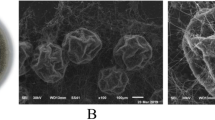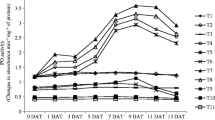Abstract
Salicylic acid (SA) was used to induce insensitivity in the callus cultures of Zingiber officinale against culture filtrate (CF) of Fusarium oxysporum f.sp. zingiberi. The treatment of callus cultures with SA (104μM) prior to selection with CF of the pathogen-increased callus survival. Exogenous application of SA resulted in increased activity of peroxidase and β-1,3-glucanase enzymes in the callus cultures. No increase in the activity of phenylalanine ammonia lyase was obtained. Two new protein bands of ∼97 and 38kDa molecular weights were obtained by SDS-PAGE analysis of soluble proteins extracted from SA-treated calli. The PR-1 monoclonal antibody used for immunodetection of induced proteins cross-reacted with the 38kDa protein band. In vitro antifungal activity of protein extract of calli treated with SA tested against the spores of F. oxysporum f.sp. zingiberi showed significant reduction in spore germination and germ tube elongation. It is concluded that in ginger, SA may result in the induction of resistance to F. oxysporum f.sp. zingiberi by inducing increased activity of peroxidase, β-1,3-glucanase and antifungal PR-proteins.
Similar content being viewed by others
References
Abeles FB and Forrence lE (1970) Temporal and hormonal control of β-1,3-glucanase in Phaseolus vulgaris L. Plant Physiology 45: 395–400
Anfoka G and Buchenauer H (1997) Systemic acquired resistance in tomato against Phytophthora infestans by pre-inoculation with tobacco necrosis virus. Physiological and Molecular Plant Pathology 50: 85–101
Babu KN, Samsudeen K and Ratnambal MJ (1992) In vitro plant regeneration from leaf-derived callus in ginger (Zingiber officinale Rosc.) Plant Cell, Tissue and Organ Culture 29: 71–74
Bera S and Purkayastha RP (1997) Identification and characterization of some PR-proteins induced by Kitazin and Rhizoctonia solani causing sheath blight of rice. Indian Journal of Experimental Biology 35: 644–649
Boller T (1985) Induction of hydrolases as a defense reaction against pathogens. In: Key JL and Kosuge T (eds) Cellular and Molecular Biology of Plant Stress (pp 247–262) Alan R Liss, New York
Bradford MM (1976) A rapid and sensitive method for quantitation of microgram quantities of protein utilizing the principle of protein-dye binding. Analytical Biochemistry 72: 248–254
Cai XZ, Zheng Z, Cai XZ and Zheng Z (1996) Effect of exogenous salicylic acid on resistance of rice seedlings to blast. Chinese Rice Research Newsletter 4: 8–9
Christ U and Mosinger E (1989) Pathogenesis-related proteins of tomato: Induction by Phytophthora infestans and other biotic and abiotic inducers and correlation with resistance. Physiological and Molecular Plant Pathology 35: 53–65
Conti GG, Bassi M, Maffi D, Violini G, Magnani L and Gatti L (1994) Induced systemic resistance against Sphaerotheca fuliginea in cucumber: Efficiency of tobacco necrosis virus (TNV) and copper sulphate (CuSO4) in eliciting defence reactions. Journal of Phytopathology 140: 123–132
Gomez KA and Gomez AA (1984) Statistical Procedures for Agricultural Research. 2nd edn. (680 p) John Wiley and Sons, New York
Hammerschmidt R, Nuckles EM and Kuć J (1982) Association of enhanced peroxidase activity with induced systemic resistance of cucumber to Colletotrichum lagenarium. Physiological and Molecular Plant Pathology 20: 73–82
Hoffland E, Hakunen J and Van Pelt JA (1996) Comparison of systemic resistance induced by avirulent and nonpathogenic Pseudomonas species. Phytopathology 86: 757–762
Jin H, Hartman GL, Nickell CD and Widholm JM (1996) Phytotoxicity of culture filtrate from Fusarium solani, the causal agent of sudden death syndrome of soybean. Plant Disease 80: 922–927
Kessmann H, Staub T, Hofmann C, Maetzke T, Herzog JE, Ward J, Uknes S and Ryals J (1994) Induction of systemic acquired disease resistance in plants by chemicals. Annual Review of Phytopathology 32: 439–459
Klessig DF, Malamy J, Hennig J, Chen Z, Sanchezcasas P, Indulski J and Grynnkiewicz G (1993) Induction, modification and reception of salicylic acid signal in plant defense. In Fritig B and Legrand M (eds) Mechanisms of Plant Defense Responses (pp 185–195) Kluwer Academic Publishers, Dordrecht
Kuć J and Preisig C (1984) Fungal regulation of disease resistance mechanisms in plants. Mycologia 76: 767–784
Laemmli UK (1970) Cleavage of structural proteins during the assembly of the head of the bacteriophage T4. Nature 227: 680–685
Linthorst HJM (1991) Pathogenesis-related proteins of plants. Critical Reviews in Plant Sciences 10: 123–150
Malamy J and Klessig DF (1992) Salicylic acid and plant disease resistance. The Plant Journal 2: 643–654
Mauch-Mani B and Slusarenko AJ (1996) Production of salicylic acid precursors is a major function of phenylalanine ammonia-lyase in the resistance of Arabidopsis to Peronospora parasitica. Plant Cell 8: 203–212
Murashige T and Skoog F (1962) A revised medium for rapid growth and bioassays with tobacco tissue cultures. Physiologia Plantarum 15: 473–479
Niderman T, Genetet I, Bruyere T, Gees R, Stinzi A, Legrand M, Fritig B and Mosinger E (1995) Pathogenesis related PR-1 proteins are antifungal. Plant Physiology 108: 17–27
Okey EN and Sreenivasan TN (1996) Salicylic acid: a factor in systemic resistance of cacao to Phytophthora palmivora. Proceedings of Brighton Crop Protection Conference on Pest and Diseases 3: 955–960
Palva TK, Hurtig M, Saindrenan P and Palva ET (1994) Salicylic acid induced resistance to Erwinia carotovora subsp. carotovora in tobacco. Molecular Plant-Microbe Interaction 7: 356–363
Peng M and Kuć J (1992) Peroxidase generated hydrogen peroxide as a source of antifungal activity in vitro and on tobacco leaf discs. Phytopathology 82: 696–699
Prachi, Sharma TR and Singh BM (2000). In vitro and in vivo phytotoxic effect of culture filtrate of Fusarium oxysporum f.sp. zingiberi on Zingiber officinale. Advances in Horticultural Science 14: 52–58
Rasmussen JB, Hammerschmid R and Zook MM (1991) Systemic induction of salicylic acid accumulation in cucumber after inoculation with Pseudomonas syringae pv. syringae. Plant Physiology 97: 1342–1347
Reglinski T, Poole PR, Whitaker G and Hoyte SM (1997) Induced resistance against Sclerotinia sclerotiorum in kiwifruit leaves. Plant Pathology 46: 716–721
Renault AS, Deloire A and Bierne J (1996) Pathogenesis related proteins in grapevines induced by salicylic acid and Botrytis cinerea. Vitis 35: 49–52
Sadasivam S and Manickam A (1992) Biochemical Methods for Agricultural Sciences (pp 96–143) Wiley Eastern Limited, Madras, India
Siegel BZ (1993) Plant Peroxidases — an organismic perspective. Plant Growth Regulation 12: 303–312
Silverman P, Seskar M, Kanter D, Schweizer P, Metraux JP and Raskin I (1995) Salicylic acid in rice: Biosynthesis, conjugation and possible role. Plant Physiology 108: 633–639
Tham L and Huttova J (1996) Accumulation of pathogenesis related proteins in barley induced by phosphate and salicylic acid. Biologia-Bratislava 51: 479–484
Van Loon LC (2000) Systemic Induced Resistance. In: Slusarenko A, Fraser RSS and Van Loon LC (eds) Mechanism of Resistance to Plant Diseases (pp 521–574) Kluwer Academic Publishers, The Netherlands
Van Loon LC, Gerritsen YAM and Ritter CE (1987) Identification, purification and characterization of pathogenesis-related proteins from virus-infected Samsun NN tobacco leaves. Plant Molecular Biology 9: 593–609
Van Loon LC and Kammen AV (1970) Polyacrylamide disc electrophoresis of the soluble proteins from Nicotiana tabacum var. ‘samsun’ and ‘samsun NN’. Virology 401: 199–211
Van Loon LC, Pierpoint WS, Boller T and Conejero V (1994) Recommendations for naming plant pathogenesis related proteins. Plant Molecular Biology Reporter 12: 245–264
Wubben JP, Eijkelboom CA and DeWit PJGM (1993) Accumulation of pathogenesis related proteins in epidermis of tomato leaves infected by Cladosporium fulvum. Netherlands Journal of Plant Pathology 99: 231–239
Xiao YS, Wang ZZ, Guo SC, Xiao YS, Wang ZZ and Guo SC (1996) The effect of salicylic acid on resistance to bacterial leaf blight in hybrid rice. Acta Phytophylatica-Sinica 23: 359–362
Author information
Authors and Affiliations
Corresponding author
Rights and permissions
About this article
Cite this article
Prachi, Sharma, T.R. & Singh, B.M. Salicylic Acid Induced Insensitivity to Culture Filtrate of Fusarium oxysporum f.sp. zingiberi in the Calli of Zingiber officinale Roscoe. European Journal of Plant Pathology 108, 31–39 (2002). https://doi.org/10.1023/A:1013915013127
Issue Date:
DOI: https://doi.org/10.1023/A:1013915013127




